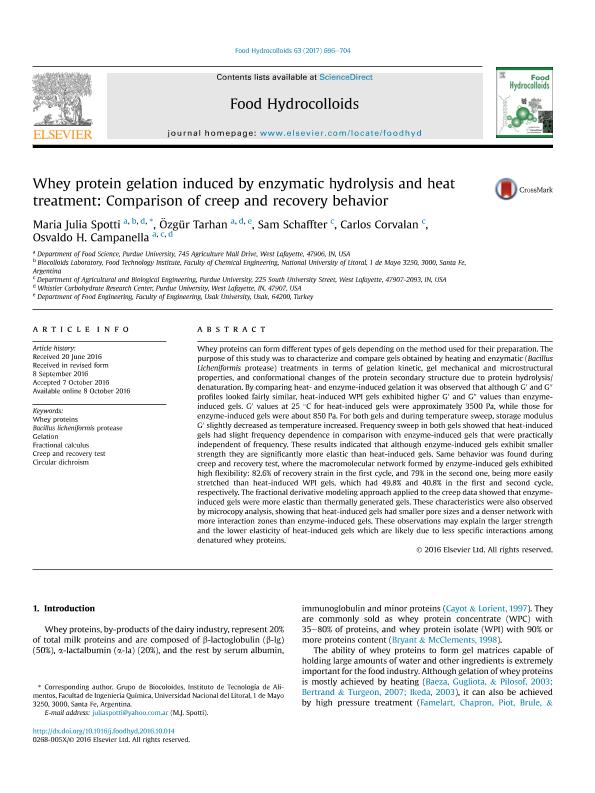Mostrar el registro sencillo del ítem
dc.contributor.author
Spotti, Maria Julia

dc.contributor.author
Tarhan, Özgür
dc.contributor.author
Schaffter, Sam
dc.contributor.author
Corvalan, Carlos
dc.contributor.author
Osvaldo Roberto, Campanella

dc.date.available
2019-03-01T19:38:36Z
dc.date.issued
2017-02
dc.identifier.citation
Spotti, Maria Julia; Tarhan, Özgür; Schaffter, Sam; Corvalan, Carlos; Osvaldo Roberto, Campanella; Whey protein gelation induced by enzymatic hydrolysis and heat treatment: Comparison of creep and recovery behavior; Elsevier; Food Hydrocolloids; 63; 2-2017; 696-704
dc.identifier.issn
0268-005X
dc.identifier.uri
http://hdl.handle.net/11336/71021
dc.description.abstract
Whey proteins can form different types of gels depending on the method used for their preparation. The purpose of this study was to characterize and compare gels obtained by heating and enzymatic (Bacillus Licheniformis protease) treatments in terms of gelation kinetic, gel mechanical and microstructural properties, and conformational changes of the protein secondary structure due to protein hydrolysis/denaturation. By comparing heat- and enzyme-induced gelation it was observed that although G′ and G″ profiles looked fairly similar, heat-induced WPI gels exhibited higher G′ and G″ values than enzyme-induced gels. G′ values at 25 °C for heat-induced gels were approximately 3500 Pa, while those for enzyme-induced gels were about 850 Pa. For both gels and during temperature sweep, storage modulus G′ slightly decreased as temperature increased. Frequency sweep in both gels showed that heat-induced gels had slight frequency dependence in comparison with enzyme-induced gels that were practically independent of frequency. These results indicated that although enzyme-induced gels exhibit smaller strength they are significantly more elastic than heat-induced gels. Same behavior was found during creep and recovery test, where the macromolecular network formed by enzyme-induced gels exhibited high flexibility: 82.6% of recovery strain in the first cycle, and 79% in the second one, being more easily stretched than heat-induced WPI gels, which had 49.8% and 40.8% in the first and second cycle, respectively. The fractional derivative modeling approach applied to the creep data showed that enzyme-induced gels were more elastic than thermally generated gels. These characteristics were also observed by microcopy analysis, showing that heat-induced gels had smaller pore sizes and a denser network with more interaction zones than enzyme-induced gels. These observations may explain the larger strength and the lower elasticity of heat-induced gels which are likely due to less specific interactions among denatured whey proteins.
dc.format
application/pdf
dc.language.iso
eng
dc.publisher
Elsevier

dc.rights
info:eu-repo/semantics/openAccess
dc.rights.uri
https://creativecommons.org/licenses/by-nc-nd/2.5/ar/
dc.subject
Bacillus Licheniformis Protease
dc.subject
Circular Dichroism
dc.subject
Creep And Recovery Test
dc.subject
Fractional Calculus
dc.subject
Gelation
dc.subject
Whey Proteins
dc.subject.classification
Alimentos y Bebidas

dc.subject.classification
Otras Ingenierías y Tecnologías

dc.subject.classification
INGENIERÍAS Y TECNOLOGÍAS

dc.title
Whey protein gelation induced by enzymatic hydrolysis and heat treatment: Comparison of creep and recovery behavior
dc.type
info:eu-repo/semantics/article
dc.type
info:ar-repo/semantics/artículo
dc.type
info:eu-repo/semantics/publishedVersion
dc.date.updated
2019-02-25T18:48:10Z
dc.journal.volume
63
dc.journal.pagination
696-704
dc.journal.pais
Países Bajos

dc.journal.ciudad
Amsterdam
dc.description.fil
Fil: Spotti, Maria Julia. Universidad Nacional del Litoral. Facultad de Ingeniería Química. Instituto de Tecnología de los Alimentos; Argentina. Consejo Nacional de Investigaciones Científicas y Técnicas. Centro Científico Tecnológico Conicet - Santa Fe; Argentina. Purdue University; Estados Unidos
dc.description.fil
Fil: Tarhan, Özgür. Purdue University; Estados Unidos. Usak University; Turquía
dc.description.fil
Fil: Schaffter, Sam. Purdue University; Estados Unidos
dc.description.fil
Fil: Corvalan, Carlos. Purdue University; Estados Unidos
dc.description.fil
Fil: Osvaldo Roberto, Campanella. Purdue University; Estados Unidos
dc.journal.title
Food Hydrocolloids

dc.relation.alternativeid
info:eu-repo/semantics/altIdentifier/url/http://www.sciencedirect.com/science/article/pii/S0268005X16305549
dc.relation.alternativeid
info:eu-repo/semantics/altIdentifier/doi/https://doi.org/10.1016/j.foodhyd.2016.10.014
Archivos asociados
